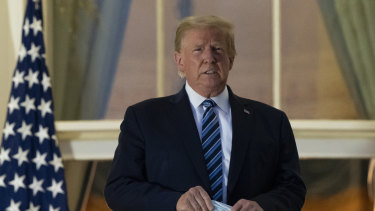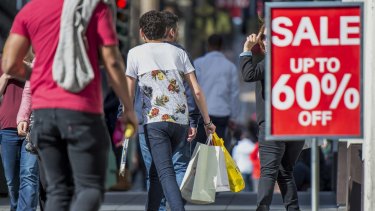Sink or swim: The US economy is searching for a lifeline
Here is the situation the US economy faces, a month before Election Day: Job growth is stalling. Layoffs are mounting. And no more help is coming, at least not right away.
American households and businesses have gone two months without the enhanced unemployment benefits, low-interest loans and other programs that helped prop up the economy in the spring. And now, after President Donald Trump’s announcement on Tuesday (US time) that he was cutting off stimulus negotiations until after the election, the wait will go on at least another month — and very likely until the next presidential term starts in 2021.

It could be a dangerous delay.
Already, many furloughs are turning into permanent job losses, and major companies like Disney and Allstate are initiating new rounds of layoffs. The hotel industry is warning of thousands of closures, and tens of thousands of small businesses are weighing whether to close up shop for good. An estimated one of every seven small businesses in the United States had shut down permanently by the end of August — 850,000 in all — according to data from Womply, a marketing platform. The deeper those wounds, the longer the economy will take to heal.
Economists say lawmakers should be acting immediately to send more money to workers marooned on unemployment by the recession, to businesses of all sizes that are struggling to survive until the pandemic abates and their customers return in full force, and to state and local governments that have seen tax revenues decline and are already moving to lay off public employees.
While they disagree about exactly how much federal aid the economy needs right now, virtually all economists, across the ideological spectrum, agree on one thing: The correct dollar figure is not “zero.” Most estimates fall in a range between $US1 trillion ($1.4 trillion) and $US2 trillion.
“The risk to waiting is that we may find ourselves in a place where we’re unable to turn back, we’ll hit a tipping point,” said Karen Dynan, a Harvard economist and Treasury Department official during the Obama administration.
R. Glenn Hubbard, a Columbia University economist who was chairman of the White House Council of Economic Advisers under President George W. Bush, said the economy still needed $US1 trillion in immediate aid for people, businesses and state governments. “Failing to act will have real economic consequences,” he said.
Jerome Powell, the Federal Reserve chair, echoed those concerns in a speech on Tuesday, arguing that failing to provide enough support carried risks for the economy.
“Too little support would lead to a weak recovery, creating unnecessary hardship for households and businesses,” he said. “Over time, household insolvencies and business bankruptcies would rise, harming the productive capacity of the economy and holding back wage growth.”
Business leaders have made urgent pleas for help, arguing that the risk of not acting could doom entire sectors. The Business Roundtable, a group of chief executives from major corporations like Apple and Walmart, warned on Tuesday evening that “communities across the country are on the precipice of a downward spiral and facing irreparable damage.”
The risk to waiting is that we may find ourselves in a place where we’re unable to turn back, we’ll hit a tipping point,
Karen Dynan, a Harvard economist and Treasury Department official during the Obama administration.
Some 36,000 franchise businesses are likely to close by winter without additional federal support, said Matthew Haller, senior vice president for government relations and public affairs at the International Franchise Association in Washington, which represents owners of gyms, salons and other chains. “The situation’s pretty dire,” he said.
Laid-off workers are also under pressure. Ernie Tedeschi, an economist at Evercore ISI, estimates that unemployed Americans will begin to exhaust the savings they were able to amass from previous rounds of aid as early as this month, leaving them struggling to buy food or pay rent. Without another aid package, the economy will regain 4 million fewer jobs through the end of next year than it would have if lawmakers had struck a deal, he said in a research note Wednesday.
The gridlock in Washington is a reversal from the spring, when fear of an imminent economic collapse led Congress to vote overwhelmingly to approve trillions of dollars in aid to households and businesses. The effort was largely successful: Households began spending again, companies began bringing back workers, and a predicted tidal wave of evictions and foreclosures mostly failed to materialise. The unemployment rate, which reached nearly 15 per cent in April, fell to 7.9 per cent in September.

But most of the aid programs expired over the summer, and in recent weeks economic gains have faltered. Economists say the loss of momentum is likely to grow worse if more aid doesn’t arrive soon. Federal Reserve officials had been expecting another aid package to arrive when they released their economic projections in September, minutes released Wednesday showed, and warned that “absent a new package, growth could decelerate at a faster-than-expected pace in the fourth quarter.”
While Republicans, Democrats and the White House have sparred over the size of another package, many economists say the amount is less important than how fast and where the money is deployed.
“When do you need money? The answer is, two months ago,” said Jason Furman, who ran the White House Council of Economic Advisers under President Barack Obama. He said it would be better to have a smaller amount of aid, passed immediately, than a larger sum approved early next year.
Unemployment benefits are a top priority for many economists. The $US600 a week in extra benefits that kept many households afloat in the spring expired at the end of July, leaving millions of families struggling to get by on only their regular state unemployment benefits, which often total just a few hundred dollars a week. Millions more people are depending on temporary programs that extend aid to those who don’t qualify for regular state benefits or whose benefits have expired. Those programs lapse at the end of the year.
Research has found that unemployment benefits are among the most effective forms of economic stimulus, because jobless workers are likely to spend the money rather than save it. But many economists said that is a secondary reason for extending benefits; the primary reason is to keep families from slipping into poverty or losing their homes.
“My principal reason for wanting the $US600 to continue is not as a macroeconomist, it’s because I’m worried about people,” said Jay Shambaugh, a George Washington University economist who served as an adviser to Obama. “I think we can afford it and not have people starve.”
The consequences of failing to provide help to jobless families would be particularly dire for low-income families, many of them Black and Hispanic. Those workers were among the last to make gains after the last recession, and have lost the most in the pandemic-induced recession.
Fed officials, in their minutes, noted that “a number of participants judged that the absence of further fiscal support would exacerbate economic hardships in minority and lower-income communities.”
Businesses are also in need of more help, particularly industries that have yet to return to full capacity as the virus persists. Major airlines began laying off workers this month after Congress failed to extend an earlier aid package. A hospitality-industry lobbying group last month released a report estimating that 1.6 million hotel workers could lose their jobs and 38,000 hotels could close without federal help. Restaurants are in similarly dire straits, especially as colder weather begins to shut down outdoor dining in much of the country.
Trump on Tuesday evening indicated he was open to signing stand-alone bills supporting the airline industry and reviving the Paycheck Protection Program, which issued more than half a trillion dollars in grants and loans to small businesses before expiring over the summer.
But while economists said those efforts were important in the first phase of the pandemic, businesses are facing new challenges that will require a different approach. For instance, any new program probably needs to be more flexible, allowing businesses to make adjustments — including laying off workers — to survive a crisis that could stretch on another year or more.
Steven Hamilton, a George Washington University economist, said lawmakers should “radically expand” a tax credit that offsets the costs of retaining employees, along with additional aid for fixed costs like rent. He said any delay in help, especially until next year, “would be catastrophic.”
“It is much faster to close a business than to start one,” he said. “It took us a decade to regain the businesses lost in just three years during the Great Recession. The labour market seems to have hit a ceiling in recent months, and a big part of that is that many workers’ former employers no longer exist.”
And while companies have begun to bring back furloughed workers, the US economy lost 216,000 government jobs in September, according to the Labor Department, with most of those cuts coming at the state and local level. Forecasters warn that much deeper cuts are coming as state and local governments reel from lost tax revenue.
The New York Times
Business Briefing
Start the day with major stories, exclusive coverage and expert opinion from our leading business journalists delivered to your inbox. Sign up for the Herald‘s here and The Age‘s here.
Most Viewed in Business
Source: Thanks smh.com